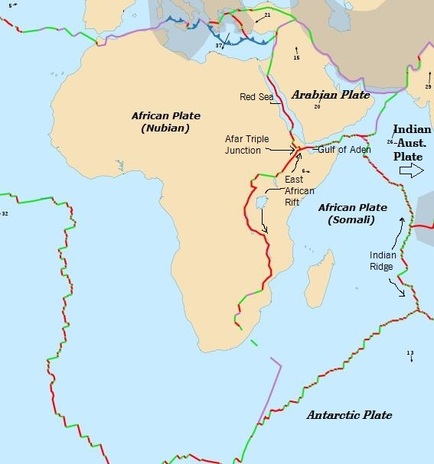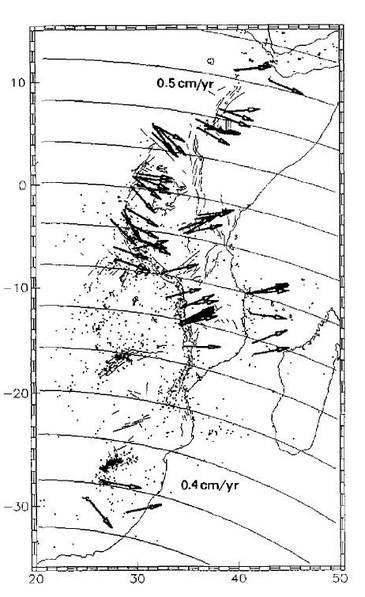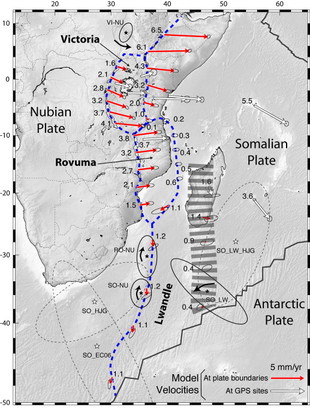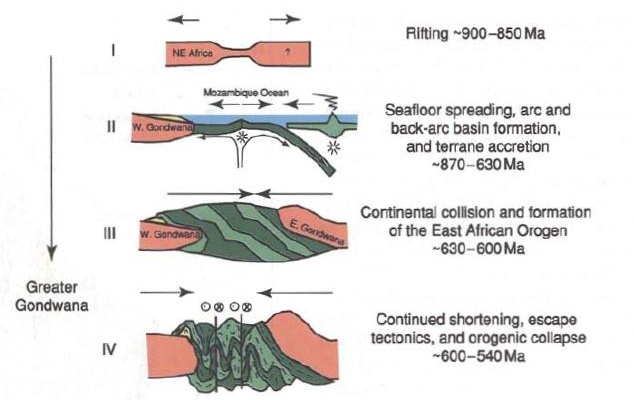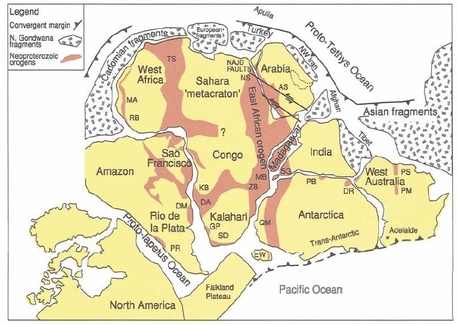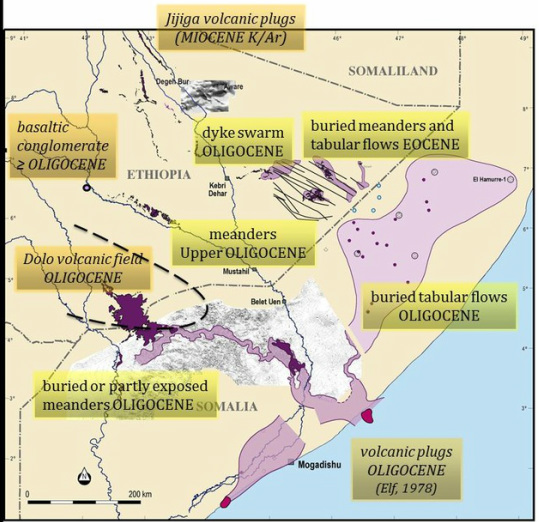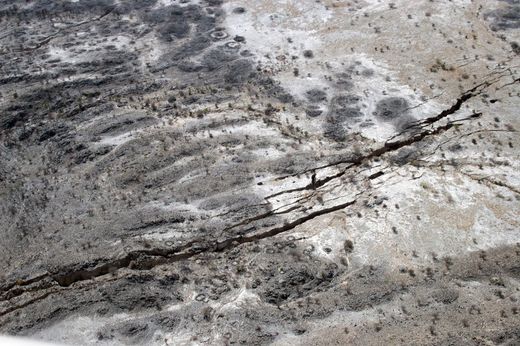A Tectonics Article By Ashten Sawitsky
Video Made by Ashten Sawitsky for project.
tectonic History
|
The Somali plate is made up of Congo and Tanzania cratons that were sutured together during the formation of the Mozambique belt in the Triassic period (Kroner and Stern, 2005). Equivalent tectonic movement with Madagascar, Seychelles and Mascarene Plateau lineaments (Emerick and Duncan, 1982) as well as relative paths identified by stationary hot spots (Comores and Reunion) suggests that the Somali plate had very insignificant motion prior to 10Ma-60Ma. Since then, the Somali plate has been separating from the rest of Africa with an average rate of ~25.4mm/ year and moved ~360km across the rift within 10Ma (figure 1). Projecting this rate suggests that within about 1 million years, there will be infilling of a new ocean between Somalia and Africa. Further extrapolation suggests that in 10 million years, a new continent will be formed and completely independent from Africa (Logatchev et al. 1972) (Emerick and Duncan, 1982).
In the north, the Somali plate is associated with the Arabian plate via the Red Sea and Gulf of Aden ridges, all of which connect to the Afar triple junction in Djibouti. The Indian/Australian plate is to the east and separated by the Indian Ridge (figure 2). Finally, the Antarctic plate joins the Somali plate at the Antarctic triple junction located near the Andrew Bain transform fault complex (Horner-Johnson et al., 2007). Residing within the Somali plate are independently moving microplates such as Lwandle, Madagascar, and Seychelles. Other identified microplates along and nearer to the African rift system are Victoria and Rovuma (figure 3) (Stamps et al. 2008) (Hartnady, 2002). |
|
Euler Axis and Rotation of Somali
The African-Somali euler rotation poles has been estimated in various different locations near the Antarctic region. The first two positions of the euler rotation axis did not incorporate microplates and therefore were inaccurately placed father south (Emerick and Duncan, 1982) (Jesten et al., 1994). The most recent euler pole of rotation has been changed to incorporate a microplate known as Lwandle which is situated between the Nubian and Somalian Plates at the south-western Indian Ridge (Horner-Johnson et al., 2007). The final euler pole rotation suggests that the Somali plate is being separated from Africa faster in the Northern area near the Afar triple junction and decreasing to minimal separation near the Southern boundary at the Antarctic triple junction (refer to slide show below).
The African-Somali euler rotation poles has been estimated in various different locations near the Antarctic region. The first two positions of the euler rotation axis did not incorporate microplates and therefore were inaccurately placed father south (Emerick and Duncan, 1982) (Jesten et al., 1994). The most recent euler pole of rotation has been changed to incorporate a microplate known as Lwandle which is situated between the Nubian and Somalian Plates at the south-western Indian Ridge (Horner-Johnson et al., 2007). The final euler pole rotation suggests that the Somali plate is being separated from Africa faster in the Northern area near the Afar triple junction and decreasing to minimal separation near the Southern boundary at the Antarctic triple junction (refer to slide show below).
Geology
|
|
The Somali plate was presumably created during the suturing of East and West Gondwana (figure 4), during which the Mozambique belt was formed consisting of medium to high grade gneiss and voluminous igneous layers (figure 5) (Kroner and Stern, 2005). The continental foundation of the Somali plate is primarily metasediments and igneous intrusives of Late Precambrian. Later followed by an episode of Paleozoic continental sedimentation through to the Mesozoic where marine sedimentation is present along the eastern edge of Somali. To the north, sediment deformation is seen paralleling the onset of the Afar triple junction, Red Sea, and Gulf of Aden depressions during the early Paleogene (figure 6) (Baker et al., 1972). There have been three consecutive magmatism uplifts in the Ethiopian and Kenya regions relating to Eocene, mid-Miocene and Plio-Pleistocene periods. These igneous systems were predominately alkaline volcanic (silicic and intermediate composition). Thus, the western flank of the Somali plate is a build-up of igneous rocks and consists of flood basalts, flood phonolites, trachytes, rhyolites and ignimbrites (figure 7) (Emerick and Duncan, 1982), (Ray et al., 2009) (Mege and Purcell, 2010) (Baker et al., 1972). Nearer to the eastern edge of the boundary, Indian Mid-ocean Ridge, the area is dominated by phyric plagioclase basalts. Conversely, near the center of the Somali plate, the Madagascar microplate petrology dominates (Ray et al., 2009) (Kroner and Stern, 2005). |
Special Features
|
Volcanics
The Dabbahu volcano erupted in 2005 causing one of the largest surface fractures recorded in human history. Within days of eruption, the surface crack reached 500 meters long resulting from a 60 km long uplifted magma dike. It is estimated that the crack will reach the Red sea in 4 million years, which is further evidence for a developing sea. This phenomenon also caused over 160 earthquakes to swarm the area (Campbell, 2009). There are more volcanoes situated throughout the East African rift such as Erta Ale. Eruptions from these volcanoes are more basaltic and alkaline; typical of mid ocean ridge affinity, unlike other continental volcanoes (Campbell, 2009) (Baker et al., 1972). |
References
Baker, B.H., Mohr, P.A., and Williams, L.A.J. 1972. Geology of the Eastern Rift System of Africa. Geological Society of America. 136: 1-68
Campbell, M. 2009. Giant crack in Africa formed in just days. New Scientist. Available at http://www.newscientist.com/article/dn18114-giant-crack-in-africa-formed-in-just-days.html.
Chu D. and Gordon R.G. 1999. Evidence for motion between Numbia and Somalia along the Southwest Indian Ridge. Nature. 398: 64-68
Emerick C.M. and Duncan R.A. 1982. Age progression volcanism in the Comores Archipelago, western Indian Ocean and implications for Somali plate tectonics. Earth and Planetary Science Letters. 60: 415-428
Hartnady C.J.H. 2002. Earthquake hazard in Africa: Perspectives on the Numbia-Somalia boundary. South African Journal of Science. 98: 425-428
Horner-Johnson, B. C., R. G. Gordon, and D. F. Argus. 2007. Plate kinematic evidence for the existence of a distinct plate between the Nubian and Somalian plates along the Southwest Indian Ridge. Journal of Geophysical research. 112: B05418
Jestin F., Huchon P., and Gaulier J.M. 1994. The Somali plate and the East African Rift Systems: present-day kinematics. Geophysics. 116: 637-654
Kroner, A., Stern, R.J. 2005. Pan-African Orogeny. Encyclopedia of Geology, 1: 1-12
Logatchev, N.A., Beloussov, V.V., and Milanovsky, E.E. 1972. East African Rift Development. Tectonophysics, 15: 71-81
Mege D., Purcell P.G., and Jourdan F. 2010. Cenozoic magmatism of the Ogaden and Somalia. Abstract and talk presented at RST in 2010.
Miles P.R., Munschy M., and Segoufin J. 1998. Structure and early evolution of the Arabian Sea and East Somali Basin. Geophysical Journal. 134: 876-888
Ray D., Banerjee R., Iyer S.D., Basavalingu B., and Mukhopadhyay S. 2009. Glass and Mineral Chemistry of Northern Central Indian Ridge Basalts: Compositional Diversity and Petrogenic Significance. Acta Geologica Sinica. 83: 1122-1135
Stamps, D.S., Calais E., Saria E., Hartnady C., Nocquet J., Ebinger C.J., and Fernandes R.M. 2008. A kinematic model for the East African Rift, Geophys. Res. Lett., 35, L05304, doi:10.1029/ 2007GL032781.
Yirgu, G., Ebinger, C.J. and Maguire, P.K.H. 2006. Structure and Evolution of the Rift Systems within the Afar volcanic province, Northeast Africa, Geological Society of London Special Publications, 259: 9-22
Campbell, M. 2009. Giant crack in Africa formed in just days. New Scientist. Available at http://www.newscientist.com/article/dn18114-giant-crack-in-africa-formed-in-just-days.html.
Chu D. and Gordon R.G. 1999. Evidence for motion between Numbia and Somalia along the Southwest Indian Ridge. Nature. 398: 64-68
Emerick C.M. and Duncan R.A. 1982. Age progression volcanism in the Comores Archipelago, western Indian Ocean and implications for Somali plate tectonics. Earth and Planetary Science Letters. 60: 415-428
Hartnady C.J.H. 2002. Earthquake hazard in Africa: Perspectives on the Numbia-Somalia boundary. South African Journal of Science. 98: 425-428
Horner-Johnson, B. C., R. G. Gordon, and D. F. Argus. 2007. Plate kinematic evidence for the existence of a distinct plate between the Nubian and Somalian plates along the Southwest Indian Ridge. Journal of Geophysical research. 112: B05418
Jestin F., Huchon P., and Gaulier J.M. 1994. The Somali plate and the East African Rift Systems: present-day kinematics. Geophysics. 116: 637-654
Kroner, A., Stern, R.J. 2005. Pan-African Orogeny. Encyclopedia of Geology, 1: 1-12
Logatchev, N.A., Beloussov, V.V., and Milanovsky, E.E. 1972. East African Rift Development. Tectonophysics, 15: 71-81
Mege D., Purcell P.G., and Jourdan F. 2010. Cenozoic magmatism of the Ogaden and Somalia. Abstract and talk presented at RST in 2010.
Miles P.R., Munschy M., and Segoufin J. 1998. Structure and early evolution of the Arabian Sea and East Somali Basin. Geophysical Journal. 134: 876-888
Ray D., Banerjee R., Iyer S.D., Basavalingu B., and Mukhopadhyay S. 2009. Glass and Mineral Chemistry of Northern Central Indian Ridge Basalts: Compositional Diversity and Petrogenic Significance. Acta Geologica Sinica. 83: 1122-1135
Stamps, D.S., Calais E., Saria E., Hartnady C., Nocquet J., Ebinger C.J., and Fernandes R.M. 2008. A kinematic model for the East African Rift, Geophys. Res. Lett., 35, L05304, doi:10.1029/ 2007GL032781.
Yirgu, G., Ebinger, C.J. and Maguire, P.K.H. 2006. Structure and Evolution of the Rift Systems within the Afar volcanic province, Northeast Africa, Geological Society of London Special Publications, 259: 9-22
